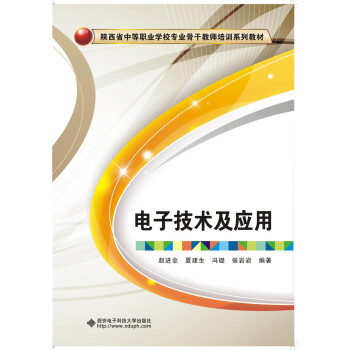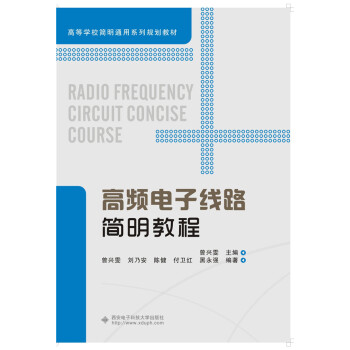

具体描述
内容简介
移动通信目前已发展成为宽带无线通信的主要技 术之一,在4G标准中,许多先进的信号处理和信息传 输技术得到了应用。《宽带移动 通信原理及应用》以英、中双语形式系统地介绍了宽 带移动通信的基本原理及相关应用,主要包括:移动 通信系统介绍、宽带无线信道、数字调制技术、扩频 谱调制和OFDM调制、信道编码、均衡与分集技术、 LTE与LTE—Advanced等。全书在编写上既注重基础原理的全面性,又能突 出重点,并兼顾了知识的先进性和实用性。部分章节 结合实际系统应用对宽带移动通信新技术进行了介绍 ,如软比特解码、OFDM、OFDMA和SC—FDMA、Turb。
和LDPC编码、MIMO和空时编码、联合的均衡与分集合 并技术、自适应调制与编码等。
本书前半部分为英文内容,后半部分为对应的中 文内容。
本书可用作电子信息类专业及其他相关专业的本 科生和研究生教材,也可供从事研究开发的工程技术 人员参考和借鉴。
目录
Chapter 1 Introduction to Mobile Communication Systems1.1 Historical introduction
1.2 Cellular concepts
1.2.1 Cellular structure and frequency reuse
1.2.2 Interference and channel assignment strategies
1.2.3 Multiple access techniques
1.2.4 Cellular system capacity
1.2.5 Roaming and handoff
1.3 Trends in mobile wireless communications
Problems
Chapter 2 Wireless Channels in Wideband Transmission
2.1 Reflection, diffraction and scattering
2.2 Ideal free space propagation
2.3 Empirical path-loss models
2.3.1 Hata model
2.3.2 COST 231 model
2.3.3 UMTS30.03 path-loss models
2.4 Path-loss Models based on ray tracing
2.5 Shadow fading
2.6 Multi-path fading
2.7 Channel models of wideband wireless systems
2.7.1 Doppler spectrum
2.7.2 Jakes Model for generating Rayleigh fading coefficients
2.7.3 Unit impulse responses of wireless channels
2.7.4 Channel modeling
2.8 Space-time channel models of wideband wireless systems
2.8.1 Basic MIMO models in frequency selective fading channels
2.8.2 Models based on antenna correlation matrices
2.8.3 Models based on geographical scatter-cluster assumption
Problems
Chapter 3 Digital Modulation Techniques
3.1 Representation of modulated signals
3.2 Signal space analysis
3.3 Modulation waveform design
3.4 Typical linear modulation techniques
3.4.1 BPSK
3.4.2 QPSK
3.4.3 MPSK
3.4.4 16QAM and MQAM
3.5 Demodulation and ML decision
3.6 BER performance in AWGN
3.6.1 Error probability and the union bound
3.6.2 Performance in AWGN
3.7 Log-Likelihood Ratio(LLR)and soft bit demodulation
3.8 Performance in flat Rayleigh fading channel
3.8.1 BER of BPSK in fiat Rayleigh fading channel
3.8.2 SER of MQAM in flat Rayleigh fading channel
3.9 Spectrum efficiency versus energy efficiency
Problems
Chapter 4 Spread Spectrum Modulation and OFDM Modulation
4.1 DSSS modulation
4.2 Spreading codes
4.2.1 PN sequences
4.2.2 Orthogonal codes
4.2.3 CDMA ~
4.3 OFDM modulation
4.3.1 Principles of OFDM
4.3.2 Advantages of OFDM modulation
4.3.3 Guard interval and cyclic prefix
4.3.4 Signal detection in OFDM systems
4.3.5 Disadvantages of OFDM
4.4 OFDMA and SC-FDMA
Problems
Chapter 5 Channel Coding
5.1 On Shannon coding theorem
5.2 Interleaving
5.3 Linear block codes
5.3.1 Generic linear block codes
5.3.2 Cyclic codes
5.4 Low Density Parity Check (LDPC) codes
5.4.1 Regular and irregular LDPC codes
5.4.2 Constructions of LDPC codes
5.4.3 Encoding of LDPC codes
5.4.4 Decoding of LDPC codes
5.4.5 Elimination of short circles
5.5 Convolutional codes
5.6 Turbo codes
5.6.1 Encoding principles of Turbo codes
5.6.2 Decoding of Turbo codes
5.6.3 Max-Log-MAP and Log-MAP
Problems
Chapter 6 Equalization and Diversity
6.1 Principles of equalization
6.2 Linear equalizers
6.3 Block-based linear equalization algorithms
6.3.1 Zero-Forcing equalizers
6.3.2 MMSE equalizers
6.4 Decision feedback equalizers
6.5 Diversity
6.5.1 Diversity forms
6.5.2 Combining techniques
6.5.3 Diversity order
6.6 RAKE receiver
Problems
Chapter 7 MIMO Systems and Space-Time Codes
7.1 Smart antenna array techniques
7.1.1 Principles of the SAA
7.1.2 Multi-user SAA techniques in mobile systems
7.2 MIMO systems
7.2.1 Signal models of MIMO systems
7.2.2 Capacity of MIMO systems
7.2.3 Spatial diversity
7.2.4 Spatial multiplexing
7.3 Space-time codes
7.3.1 Space-time code design criteria
7.3.2 Linear space-time block codes
7.3.3 Space-time trellis codes
7.4 MIMO-OFDM systems
7.4.1 MIMO-OFDM systems with spatial diversity
7.4.2 MIMO-OFDM systems with spatial multiplexing
7.5 Multi-user MIMO systems
7.5.1 Multi-user MIMO-CDMA systems
7.5.2 Multi-user MIMO-OFDM systems
7.6 Multi-user detection and MU-MIMO
7.6.1 Multi-user detection
7.6.2 Single-user detection model
7.6.3 SU-MIMO and MU-MIMO
Problems
Chapter 8 Adaptive Modulation and Coding
8.1 Principles of AMC
8.2 Parameters related to AMC
8.2.1 SNR, error rates and throughput
8.2.2 Reexamination of spectrum efficiency of MQPSK and MQAM
8.3 Threshold determination
8.3.1 Threshold determination based on BER or BLER
8.3.2 Throughput-based threshold determination
8.4 AMC techniques for OFDM systems and MIMO-OFDM systems
8.4.1 Individual MCS scheduling for OFDM systems
8.4.2 Subband-based AMC for OFDM systems
8.4.3 AMC for MIMO-OFDM systems
8.5 Combining AMC with HARQ
8.5.1 Retransmission types in HARQ
8.5.2 AMC in HARQ retransmissions
Problems
Chapter 9 LTE and LTE-Advaneed
9.1 System architecture evolution
9.1.1 Evolved packet core
9.1.2 Evolved UMTS terrestrial radio access networks
9.2 Physical layer descriptions
9.2.1 Frame structure
9.2.2 Resource block structure
9.3 Logical channels, transport channels, and physical channels
9.3.1 Logical channels
9.3.2 Transport channels
9.3.3 Physical channels
9.3.4 Reference signals in the physical layer
9.4 LTE transmitting schemes in the baseband
9.4.1 Uplink transmitting schemes
9.4.2 Downlink transmitting schemes
9.5 Detection schemes
9.5.1 Uplink detection
9.5.2 Downlink detection
9.5.3 Timing offset estimation based on DMRS
9.5.4 Fractional frequency offset estimation based on DMRS
9.6 LTE-Advanced
9.6.1 Carrier aggregation
9.6.2 Enhanced MIMO techniques
9.6.3 Wireless relays
9.6.4 CoMP techniques
9.6.5 The eICIC-HN techniques
References
用户评价
这本《宽带移动通信原理及应用(双语版)》的外观设计相当专业,封面采用了沉稳的蓝色调,搭配银色的书名,给人一种科技感和学术范。书页纸质厚实,印刷清晰,即便长时间翻阅也不会感到疲劳。我之所以会被这本书吸引,很大程度上是因为我对移动通信技术一直抱有浓厚的兴趣。从最早的2G时代,到如今我们习以为常的4G、5G,每一次技术的飞跃都深刻地改变着我们的生活方式,带来了前所未有的便利。我尤其想了解,在这背后究竟蕴含着哪些精密的理论支撑和创新性的技术应用。书名中的“宽带”二字,更是点明了其关注的核心,意味着它将深入探讨如何实现更高的数据传输速率和更广阔的网络覆盖,这对于理解未来通信的发展趋势至关重要。同时,“原理及应用”的组合,预示着这本书不仅会讲解理论知识,还会结合实际案例,这对我这样希望将理论与实践相结合的学习者来说,无疑是一大福音。我期待通过这本书,能够系统地梳理宽带移动通信的核心概念,比如OFDM、MIMO等关键技术,并且了解它们是如何在实际的移动通信系统中得以实现的。
评分对于我而言,选择一本专业书籍,除了其内容本身的价值,还有一个重要的考量就是语言的呈现方式。这本书采用“双语版”的形式,这无疑是一个非常贴心的设计。对于我们这些非母语为英语的学习者来说,直接阅读英文原版技术文献常常会遇到理解上的障碍,而翻译版本又可能在术语的准确性和专业性上有所折扣。一本优秀的双语书籍,可以帮助我们对照理解,加深记忆,甚至在阅读中同步提升英语的专业词汇量和阅读能力。我深信,在学习尖端科技领域时,能够直接接触到国际前沿的表述方式,对于保持信息的新鲜度和准确性至关重要。这本书如果能做到中英对照流畅自然,并且翻译准确到位,那么它将成为我学习移动通信技术过程中不可多得的宝贵资源。我希望能看到书中对于关键技术术语的解释,能够同时给出英文原文和中文释义,并且在行文中,如果能适时地对一些具有文化或语境差异的概念进行说明,那就更加完美了。
评分我对技术发展的思考,往往是站在社会进步的角度。移动通信技术的每一次革新,都极大地促进了信息资源的传播和共享,缩短了时空距离,深刻地改变了社会结构和人们的生活习惯。从最初的语音通话,到短信,再到如今的视频、直播、云服务,每一次技术的进步都带来了新的可能性。《宽带移动通信原理及应用》这本书,听起来就像是揭示了这一切变化的“幕后故事”。我尤其对“宽带”以及它所带来的“应用”充满了好奇。我希望这本书能够让我理解,为什么我们能够实现如此高速率的通信,这种“宽带”究竟是依靠哪些关键的技术突破才得以实现的?是硬件的革新,还是算法的进步?同时,我也非常期待书中能够阐述这些技术是如何落地,如何融入到我们生活的方方面面,比如智能手机的演进,5G在智慧医疗、远程教育、工业自动化等领域的具体应用,以及这些应用对社会带来的积极影响。
评分我是一个对未来技术发展充满好奇的普通爱好者,尤其对我们生活中无处不在的移动通信网络感到惊叹。从手机里流畅观看高清视频,到远程视频会议不受干扰,再到物联网设备的万物互联,这一切都离不开背后强大的通信技术支撑。我一直想知道,这些看似神奇的功能是如何实现的,例如,为什么我的手机信号有时候会突然变弱,又是什么技术能够让无数设备同时接入网络而不会拥堵。这本书的书名《宽带移动通信原理及应用》听起来就非常契合我的兴趣点。我希望它能够用相对易懂的方式,将那些复杂的原理讲述清楚,比如“宽带”究竟意味着什么,它与我们日常说的“网速快”有什么样的技术联系。同时,“应用”这个词也让我充满了期待,我希望能看到书中能够介绍一些实际的通信系统案例,例如不同运营商的网络是如何部署的,智能手机的通信模块是如何工作的,甚至是一些前沿的5G、6G技术在现实生活中的应用场景,比如自动驾驶、智慧城市等,让我能够更直观地感受到技术的力量。
评分作为一名在通信行业一线工作的工程师,我深知理论知识与实际操作之间的联系有多么紧密。在日常工作中,我们经常会遇到各种通信难题,需要深刻理解其背后的原理才能有效地解决。一本优秀的教材,应该能够帮助我们从宏观上把握通信系统的架构,理解各种关键技术的设计思路,并进一步指导我们在实际工程中如何去实现和优化。这本书《宽带移动通信原理及应用》的标题,正好触及了我的工作需求。我关注的重点在于“原理”部分,希望它能对诸如信道编码、多址技术、扩频技术、调制解调等核心概念进行深入浅出的剖析,并且能够结合最新的研究成果和行业标准。同时,“应用”部分也非常重要,我希望看到书中能够提供一些实际系统的设计案例,或者对一些典型的应用场景进行详细分析,比如4G LTE、5G NR等,并且能够提及一些当前面临的挑战和未来的发展方向,这样有助于我更新知识储备,提升解决实际问题的能力。
相关图书
本站所有内容均为互联网搜索引擎提供的公开搜索信息,本站不存储任何数据与内容,任何内容与数据均与本站无关,如有需要请联系相关搜索引擎包括但不限于百度,google,bing,sogou 等
© 2025 book.cndgn.com All Rights Reserved. 新城书站 版权所有















![航空航天精品系列:数字音视频技术及应用(第2版) [Digital Audio and Video Technology and Applications] pdf epub mobi 电子书 下载](https://pic.qciss.net/11909169/5729bf16Nbe83251a.jpg)
![脑机接口植入式微纳器件(英文版) [Implantable Neural Devicefor Brain Computer Interactive Microsystem Acquisition] pdf epub mobi 电子书 下载](https://pic.qciss.net/11909356/570e14d0Nae99ab9c.jpg)



